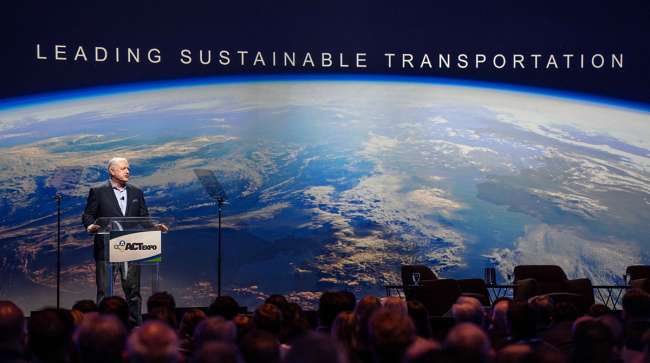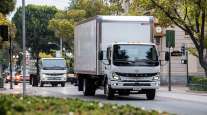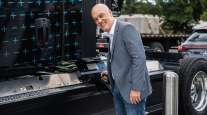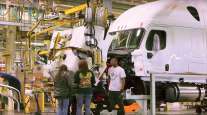Features Editor
DTNA's O’Leary: No Time to Waste Building EV Infrastructure

[Stay on top of transportation news: Get TTNews in your inbox.]
ANAHEIM, Calif. — Daimler Truck North America CEO John O’Leary called for the industry to move at “the speed of right” to realize a future of sustainability as it moves forward with electrification and zero-emission technology.
O’Leary made the comments during his keynote address at the Advanced Clean Transportation Expo on May 1.
In front of a standing-room crowd, O’Leary stressed that it’s about “doing the right things the right way for the right reasons at the right time.” He broke down what he called a “Formula of Success,” a three-pronged solution to “facilitating a transformation” to electrification in the United States.”
“Allow me to share the stark reality that vehicles are only one part of a three-pronged equation facilitating industry transformation,” O’Leary said. “Beyond promising alternatives, the total cost of ownership must be equal to or better than what is currently available, and infrastructure for refueling or recharging must be ubiquitous.”
"We all want to decarbonize this industry, but a charging infrastructure must be present. " @DaimlerTruck CEO John O'Leary. #ACTExpo @ACTExpo pic.twitter.com/1oE0bWSWE3 — Michael Freeze (@MichaelVFreeze) May 1, 2023
O’Leary pointed to DTNA’s history with electric and zero-emission vehicles as well as competitors and startups that have offered products and services in the EV segment.
“Many creative new startups joined our industry to introduce vehicles of their own with these applications. While these vehicles can’t meet all the demands of industry, they represent a formidable start in eliminating tailpipe emissions for medium- and heavy-duty vehicles,” he said. “In the meantime, we will continue to improve on our technology in order to further reduce emissions as much as possible.”
O’Leary also talked about the industry methodology to the total cost of ownership (TCO) and suggested that the concept of the vehicle life cycle should be approached holistically.
ACT Expo 2023 from GNA on Vimeo.
“In order to deliver competitive TCO, we must ensure we’re doing things the right way, making sure we’re building a complete ecosystem right at the start and with the future in mind,” he said, adding that DTNA established its supply chain to bring the cost per kilowatt hour of its batteries down to price parity.
O’Leary also noted some of DTNA’s battery life cycle achievements.
“We mirrored our remanufacturing structure with investments that enable us to efficiently refurbish battery packs in the field. We reached agreements with partners with second life, stationary energy storage project, which batteries can be economically repurposed,” he said. “And we’ve established the needs of raw material reclamation to ensure that battery at end of life does not become dangerous and expensive toxic waste.”
Despite the advancements through vehicle manufacturing and TCO, O’Leary noted, the lack of charging infrastructure has to be addressed to bring the future of sustainability to a reality.
“What we’re finding, or more importantly, what our customers can’t find, is the charging infrastructure to run these products,” he said. “Infrastructure build-outs are flailing. We’re destined to fail to meet the ambitious goals of the state, of our country and the world until emphasis is put on meeting the charging needs of the electric fleet.”
Introducing Greenlane, our public charging infrastructure joint venture with NextEra Energy Resources and BlackRock. The charging network will provide battery-electric commercial vehicles access to reliable, sustainable charging across the U.S. Learn more: https://t.co/hadbVQYxim pic.twitter.com/IKK6Ma2U7s — Daimler Truck NA (@DaimlerTruckNA) April 28, 2023
O’Leary pointed to DTNA’s recently announced partnership with NextEra Energy and BlackRock Renewable Power called Greenlane, a network of electric charging stations for their mutual customers. He also hinted about expansion plans on both coasts as well as Texas.
O’Leary estimated that the calculated investment in charging infrastructure needed to meet nationwide 2032 targets would cost nearly $52 billion just for medium- and heavy-duty vehicles. “That is the commitment required to meet the need for the increased energy generation transmission and distribution,” he explained, adding the cost does not include real estate. O’Leary also mentioned that California would have add 30 DC chargers every day until 2026 to meet its requirements.
During the first #ACTexpo keynote presentation, John O’Leary, President and CEO of @DaimlerTruckNA, shared that sustainable commercial #transportation depends not only on clean vehicles but also on the competitive total cost of ownership and dependable charging #infrastructure. pic.twitter.com/LH3635Rflp — Advanced Clean Tech News / ACT Expo (@ACTExpo) May 1, 2023
“If we ignore this reality, if we ignore the energy demand, if we ignore the differences in charging needs, we’re going to find a lot of equipment sitting idle on the back lots,” O’Leary warned. “These vehicles will not be in the field performing the jobs that were intended.”
O’Leary told the attendees that although questions about charging infrastructure appear overwhelming, he believes the answer involves the industry coming together, including OEMs, public utility companies and governments on the local, state and federal levels.
“We will all need to offer a financial contribution to resolve this issue,” he said. “Beyond the money, it will take the foresight of smart regulators and legislators to work with industry to navigate bureaucratic burdens that stand in the way. We see the benefit of working hand in hand with utilities and government.”

This special "Inside The List" episode features the Transport Topics 2023 Top 100 largest logistics companies. Hear the program above and at RoadSigns.TTNews.com.
O’Leary recognized U.S. Sen. Ron Wyden (D-Ore.) for his support with the funding found in the Infrastructure Investment and Jobs Act and Inflation Reduction Act to help with the purchase of medium- and heavy-duty zero-emission vehicles.
O’Leary also told the audience that to achieve a sustainable charging infrastructure, efforts must be more coordinated and operate better than a light-passenger-vehicle industry that has been susceptible to a lack of interoperability and uncommitted stewardship.
He also warned that trucking industry needs to escape the “delusion that the zero-emission technology industry will completely supplant diesel today, or that it will be ready to do it next year or even five years from now.”
“So instead of generating headlines this week, instead of celebrating what has been delivered, instead of patting ourselves on the back, I encourage everyone to join us and roll up our sleeves,” O’Leary said. “Let’s be honest about the problems. Let’s drop the hyperbole. Let’s connect and address the challenges. Let’s move together at the speed of right.”
Want more news? Listen to today's daily briefing below or go here for more info:




